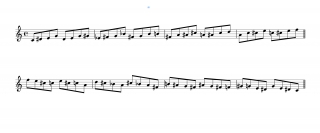Lately, during the parts of my practice sessions that I devote to double-tonguing, I’ve noticed a change. The technique is becoming smoother, the notes more connected and better sounding. I’m now double-tonguing scales, licks, and patterns in sixteenth notes with increasing comfort and accuracy throughout the full range of my saxophone at a tempo up to 140 mm. While I may not make any great gains in speed anytime soon, I can definitely tell the difference in accuracy and quality of sound since my last post on double-tonguing.
What is making the difference? Several things, I think.
* A responsive reed. I’ve found that having the right reed makes a big difference in how well I’m able to execute double-tonguing. A reed that combines instant responsiveness with just enough resistance to be lively–the kind of crisp, richly resonant reed that is a joy to play–is also the ideal reed for double-tonguing. Reeds that are too hard get balky in double-tonguing, and reeds that are too soft have their intonation issues amplified.
For most playing demands, I can get by with a fairly broad spectrum of reeds, but double-tonguing seems to be a finickier technique in that regard.
* Reversing the double-tongue syllable order. Instead of playing “da-ga-da-ga,” I’ll do some exercises using single tones as well as scales starting with the glottal articulation first, thus: “ga-da-ga-da.” I also practice articulation using my glottis only: “ga-ga-ga-ga.” My aim is to develop the response in the back of my throat.
This approach really helps! Try it yourself. Warm up with a minute or two of these glottal exercises, then shift to the standard double-tonguing pattern, “da-ga-da-ga,” and see whether you don’t notice an improvement.
* As an adjunct to the preceding point, practice all of the above articulations without your horn. See how fast you can do them, and pay attention to any subtle changes you’re making as you build up speed. I use this “dry firing” approach when I’m driving in my car. What better way to put my drive time to good use?
* Practice. That’s right–practice. There’s no magical secret for learning double-tonguing. One simply has to stick with it. As I do so, I’m finding that my embouchure, oral chamber, tongue, and air stream are intuitively making the adjustments they need to make. Also, as I work at connecting double-tonguing with scales and licks, my fingering technique is becoming cleaner. It has to in order to link up precisely with the rapid articulation of double-tonguing.
I’m at a point now where this technique is becoming a functional part of my playing. Not that I use it often, but I am using it more frequently in a variety of applications with increasing success.
An article by the Peabody Institute states that “a fast single tongue can articulate sixteenth notes at quarter note equals 152. Some people can even reach speeds of up to 168 for brief periods. The double tongue can achieve speeds as high as of 232!”
Hmmm…okay. My own single-tonguing is by no means up to to the speed of these racehorses. Of course, I haven’t really worked at it, but according to the article, some saxophonists can single-tongue faster than I can presently double-tongue. That’s fine with me. I’m not out to win any speed contests, just grow as a player. My guess is that most saxophonists who read this article and my other articles on double-tonguing are more daunted by than adept at the technique, so I figured I would share my personal journey as I took on the challenge of learning it.
The Peabody article also says, “The double tonguing technique is a natural technique that is actually simple to learn and master. A few weeks of hard work can produce remarkable results.”
That has not been my experience. Of course, I’m not a Peabody student under the tutelage of a master saxophone professor. I’m a self-didact guided by no instructor other than my own instincts. I will say that at the very beginning, double-tonguing indeed came to me with ridiculous ease, and right out of the gate I was executing sixteenth notes like machine gun fire. Then I put the horn in my mouth, and suddenly it all fell apart. I was left with the realization that the technique was going to take work, patience, and dogged persistence.
Today, not quite a year later, I can tell you that the persistence pays off. Whether I’ll ever be able to double-tongue sixteenth notes at 232 mm, or even 200, only time will tell. What’s certain for now is that this technique which can seem so formidable and frustrating at the beginning is one that a saxophonist can actually acquire and use with increasing mastery. If I can pull it off, so can you. You just have to make up your mind that you’re going to do it–and then follow through with patience and consistency.




